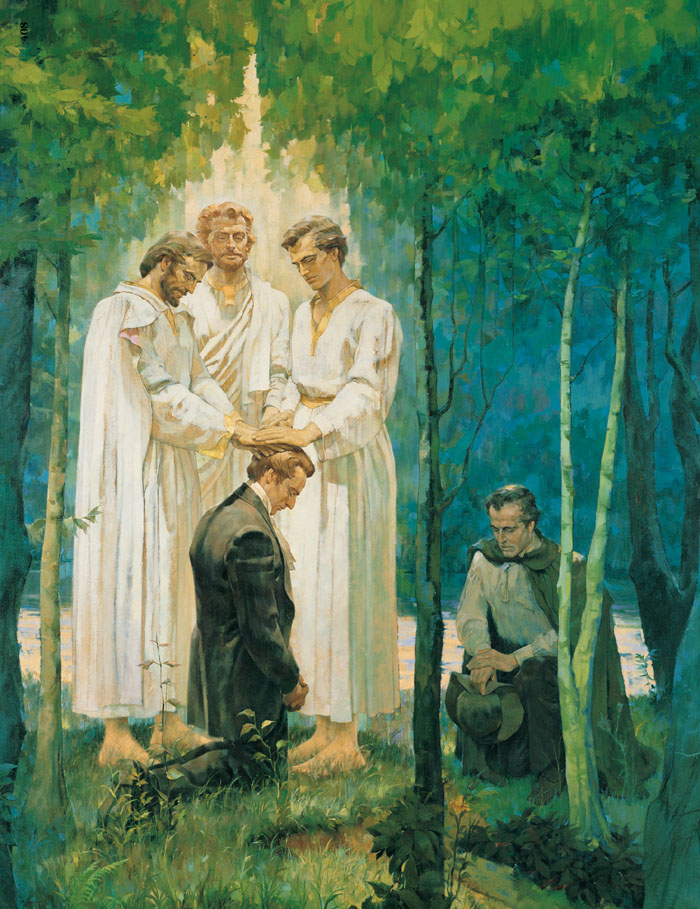
This is the last installment of Our Foundation Stories, I promise!
As a child, I heard the story of the restoration of the Aaronic and Melchizedek priesthoods this way: In May of 1829 Joseph Smith and Oliver Cowdery were praying in the woods about baptism and had John the Baptist appear to them, put his hands on their heads, and recite the following, currently found in D & C Section 13: Upon you my fellow servants, in the name of Messiah, I confer the Priesthood of Aaron, which holds the keys of the ministering of angels, and of the gospel of repentance, and of baptism by immersion for the remission of sins…”
Some time later, Joseph and Oliver again were in the woods and John, James, and Peter appeared to them, put their hands on Joseph’s and Oliver’s heads, and restored the Melchizedek priesthood.
Certain details were fuzzy here, but I got the gist. Joseph and Oliver were ordained like every other 12 year old boy I knew, even dressing up for the occasion, as Church art depicted. (Can you imagine an imageless Church manual? We would have to use our own imaginations!)
I later majored in history at BYU, where I learned to distinguish primary from secondary sources, and to assign relative weights of reliability to certain primary accounts over others based on many factors like whether the person writing was an eyewitness to the events described, length of time between the event and its recording, potential motives of the writers, etc.
When I turned this rudimentary training on the sources describing the stories above, I found the records to be vague and contradictory, more so than in the case of Joseph’s different accounts of the First Vision. This is partly because Joseph had a co-participant, Oliver Cowdery, who left his own account of these experiences, and that many other early Church members wrote as if they did not hear of these ordinations until 1834 or 1835. Cowdery’s account is especially interesting, as he mentions only one occasion of priesthood bestowal, only one priesthood, only one angel visiting, and declines to name the angel as either John the Baptist or Peter, James, and John. (Note that the Church has added an “s” to “holy angel(s) in the link to the Oliver Cowdery account above to soften the ambiguity, under the guise of correcting “spelling, grammar, and punctuation”. Compare to the wording here)
Parley Pratt, John Corrill, Lyman Wight, and David Whitmer each leave accounts which make it appear that the Melchizedek or Higher Priesthood was first revealed to the church in a June 1831 conference, and was unknown before that time.
So where did our contemporary story of two separate priesthood bestowals come from? It appears that the line upon line development of church doctrine made clear after the organization of the church that two priesthoods, arranged hierarchically, were necessary for Church governance. Revelations included in the Book of Commandments (later renamed The Doctrine and Covenants) were edited later to include references to both priesthood bestowals. (Editing revelations was a common practice in the early years of the Church.)
B.H. Roberts of the Seventy even attempted to fix a timespan for the second bestowal of the priesthood to the period between the May 15 first bestowal and the end of June 1829, based on some conjectures flowing from assumptions based on the edited revelations (e.g. Section 27). This is likely where our sense of certitude on the subject comes from.
My questions are these:
Since I, and probably many others, were raised in the Church with the very definite, specific chronology for two separate priesthood bestowals, and this appears (although La Mar Petersen, Bill Hartley, and Larry Porter have attempted to rescue the Roberts chronology) to be highly questionable given the testimony of the sources, what do we do with this story?
Does the restoration of priesthood/authority need to have been a literal laying on of hands by resurrected beings in the same order in which 12 year old boys and 18 year old men experience it in the contemporary Church?
Does imagining that things happened this way make it easier for LDSaints to serve confidently in the Church, fulfilling their callings, learning to love God and their neighbor?
Could God have restored priesthood by an act of will, divine fiat?
Why do we rely on these stories as told and recounted in our secondary literature?
